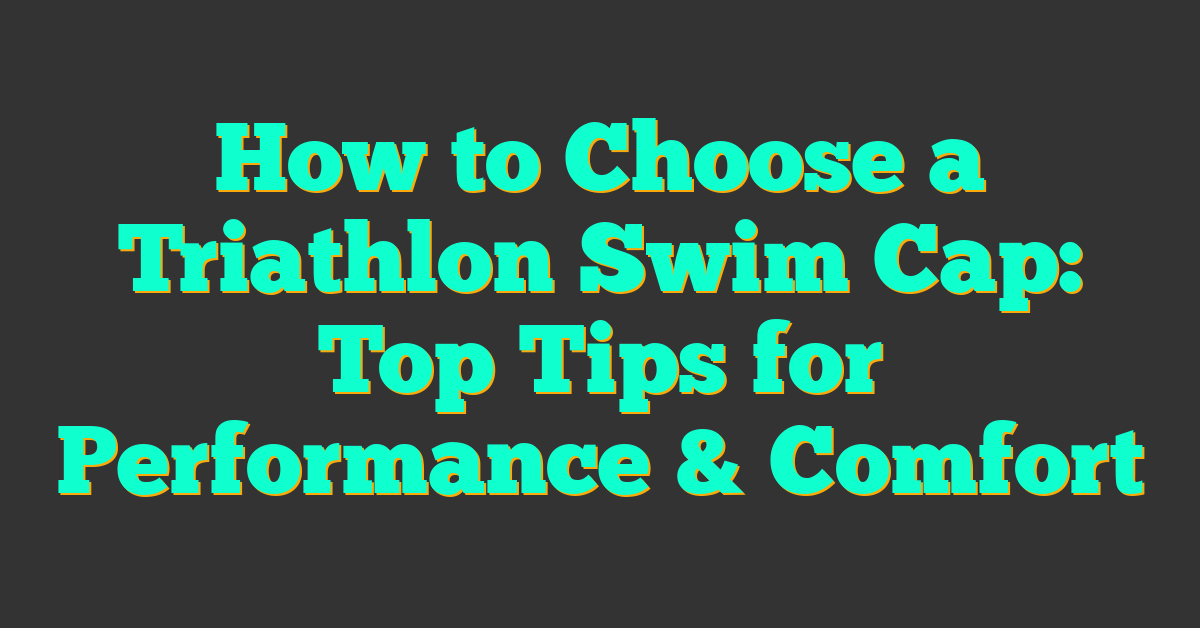Choosing the right triathlon swim cap can make a big difference in your performance and comfort during the race. I’ve found that the perfect cap not only protects your hair but also enhances your hydrodynamics, giving you that extra edge.

With so many options available, it can be overwhelming to decide which one suits your needs best. From silicone to latex and different styles, each type offers unique benefits. Let me guide you through the key factors to consider so you can make an informed choice and focus on smashing your personal best.
Importance of Choosing the Right Swim Cap
Selecting the right swim cap directly impacts my triathlon performance and comfort. A well-fitted cap minimizes water resistance, allowing me to glide more efficiently through the water. According to a study by the International Triathlon Union, reducing drag can enhance swim speed by up to 5%.
Protecting my hair is another crucial factor. A high-quality swim cap shields my hair from chlorine and saltwater, preventing damage and reducing tangling. Over time, this protection maintains my hair’s health, eliminating the need for frequent conditioning.
Comfort plays a significant role during long-distance swims. A cap that fits snugly avoids irritation and distractions, enabling me to focus solely on my performance. Additionally, the right material ensures durability and flexibility, accommodating different water temperatures without compromising comfort.
Here’s a quick overview of how different cap materials affect performance:
| Material | Drag Reduction | Durability | Comfort Level |
|---|---|---|---|
| Silicone | High | High | Medium |
| Latex | Medium | Low | High |
| Lycra | Low | Medium | High |
Understanding these factors helps me choose a swim cap that aligns with my specific needs, enhancing both my efficiency and overall race experience.
Types of Triathlon Swim Caps
When selecting a swim cap, I consider the different types to find the best fit for my needs. Here’s an overview of the main options:
Silicone Swim Caps
I choose silicone caps for their durability and snug fit. They reduce water resistance by up to 5%, helping improve my swim speed. These caps resist tearing and last longer, making them ideal for long-distance triathlons. Additionally, silicone caps provide excellent coverage, keeping my hair secure throughout the swim.
Latex Swim Caps
For a lightweight and cost-effective option, I opt for latex caps. They conform tightly to my head, minimizing drag. Although they’re less durable than silicone, latex caps work well for short-distance triathlons. Their flexibility makes them easy to put on and take off.
Lycra Swim Caps
I prefer Lycra caps when comfort is a priority. They accommodate thicker hair without excessive compression. While they offer minimal drag reduction, Lycra caps are perfect for training sessions and non-competitive swims. Available in various colors, they also allow me to express my personal style.
Key Features to Consider
When choosing a triathlon swim cap, I focus on several key features to ensure optimal performance and comfort.
Fit and Comfort
A well-fitted cap enhances performance and minimizes distractions. I prefer caps that snugly cover my head without causing discomfort. Silicone materials offer the elasticity I need, accommodating different head sizes and hair types. For example, a proper fit keeps the cap in place during long swims, allowing me to concentrate on my race.
- Snug Fit: Keeps the cap secure during the swim.
- Comfort Level: Reduces irritation during extended distances.
- Size Variability: Adapts to various head shapes and hair thickness.
Material and Durability
The cap’s material affects both performance and lifespan. I choose silicone caps for their durability and resistance to heat, making them suitable for frequent use. Latex caps are lightweight, which I use for shorter events, though they wear out quicker. Lycra caps offer flexibility and comfort, ideal for training sessions, but they may not last as long with regular use.
| Material | Durability | Drag Reduction | Cost |
|---|---|---|---|
| Silicone | High | Low | $$ |
| Latex | Medium | Medium | $ |
| Lycra | Low | Low | $ |
Hydrodynamics
Reducing drag is essential for faster swim times. I look for caps with smooth surfaces, like silicone, to minimize water turbulence. Streamlined designs help me glide more efficiently through the water. According to the International Triathlon Union, a hydrodynamic cap can decrease drag by up to 5%, which positively impacts my swim speed.
Popular Brands and Models
- Speedo Fastskin3 Elite+: Engineered with high-quality silicone, this cap offers exceptional hydrodynamics and durability. It provides a snug fit that reduces drag, ideal for competitive triathletes.
- TYR Competitor Pro: Crafted from smooth silicone, this cap ensures a comfortable fit and minimizes water resistance. Its low-elastic stretch accommodates various head sizes effectively.
- Blueseventy OtherPlanet Gel: Features a unique gel texture that enhances grip without adding significant drag. Designed for long-distance triathlons, it balances comfort and performance.
- Orca OX10 Composite: Combines silicone and lycra for optimal flexibility and durability. This cap offers superior hygiene features with antimicrobial properties, suitable for frequent training sessions.
- Aqua Sphere Fastskin Elite: Provides a streamlined design with reinforced edges to maintain shape during intense swims. Its seamless construction reduces irritation and improves swim efficiency.
Budget and Price Considerations
Choosing a triathlon swim cap involves balancing quality and cost to fit your budget. Swim caps typically range from $5 to $30, depending on material and brand.
Price Ranges
| Material | Price Range (USD) |
|---|---|
| Silicone | $15 – $30 |
| Latex | $5 – $15 |
| Lycra | $10 – $20 |
Factors Affecting Price
- Material Quality: Silicone caps offer durability and performance at higher prices, while latex caps are more affordable yet less durable.
- Brand Reputation: Brands like Speedo and TYR charge premium prices due to their reliability and advanced designs.
- Durability: Higher-priced caps last longer, reducing the need for frequent replacements and providing better long-term value.
Value for Money
Investing in a mid-priced swim cap often provides the best balance between cost and quality. Assess your training frequency and race participation to determine if spending more on a durable cap benefits your performance and budget.
Conclusion
Choosing the right triathlon swim cap can make a big difference in your performance and comfort. I hope the insights shared here help you find a cap that fits well and meets your needs. Whether you prioritize durability, comfort, or drag reduction, there’s a perfect cap out there for you. Investing time in selecting the right gear ensures you can focus on what truly matters during your race. Happy swimming and best of luck in your next triathlon!










